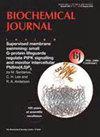Phosphorus-specific, liquid chromatography inductively coupled plasma mass-spectrometry for analysis of inositol phosphate and inositol pyrophosphate metabolism.
IF 4.3
3区 生物学
Q2 BIOCHEMISTRY & MOLECULAR BIOLOGY
引用次数: 0
Abstract
Inositol phosphate (InsP) and diphosphoinositol phosphate (PP-InsP) analysis in tissues is plagued by multiple difficulties of sensitivity, regioisomer resolution and the need for radiolabeling with metabolic precursors. We describe a liquid chromatography (LC) inductively coupled plasma (ICP) mass spectrometry (MS) method (LC-ICP-MS) that addresses all such issues and use LC-ICP-MS to analyse InsPs in avian tissues. The highly sensitive technique tolerates complex matrices and, by powerful chromatography, resolves in a single run multiple non-enantiomeric myo-inositol tetrakisphosphates, myo-inositol pentakisphosphates and all inositol hexakisphosphates, including myo-inositol 1,2,3,4,5,6-hexakisphosphate (phytate), known in nature. It also separates and quantifies diphospho myo-inositol pentakisphosphate (PP-InsP5) isomers from their biological precursors and from 1,5-bis-diphospho myo-inositol 2,3,4,6 tetrakisphosphate (1,5-[PP]2-InsP4). Gut tissue inositol phosphates, belonging to a non-canonical, lipid-independent pathway, are shown to differ from phytate digestion products and to be responsive to diet.磷酸特异性液相色谱-电感耦合等离子体质谱法分析磷酸肌醇和焦磷酸肌醇代谢。
组织中肌醇磷酸(InsP)和二磷酸肌醇磷酸(PP-InsP)的分析受到敏感性、区域异构体分辨率和代谢前体放射性标记的多重困难的困扰。我们描述了一种液相色谱(LC)电感耦合等离子体(ICP)质谱(MS)方法(LC-ICP-MS),该方法解决了所有这些问题,并使用LC-ICP-MS分析了禽类组织中的InsPs。这种高度敏感的技术可以承受复杂的基质,并通过强大的色谱,在一次运行中分解多种非对映体肌醇四磷酸、肌醇五磷酸和所有肌醇六磷酸,包括肌醇1,2,3,4,5,6-六磷酸(植酸盐),在自然界已知。它还可以从生物前体和1,5-二磷酸肌醇2,3,4,6四磷酸(1,5-[PP]2- insp4)中分离和定量二磷酸肌醇五磷酸(PP- insp5)异构体。肠道组织肌醇磷酸盐属于非规范的脂质独立途径,与植酸消化产物不同,并对饮食有反应。
本文章由计算机程序翻译,如有差异,请以英文原文为准。
求助全文
约1分钟内获得全文
求助全文
来源期刊

Biochemical Journal
生物-生化与分子生物学
CiteScore
8.00
自引率
0.00%
发文量
255
审稿时长
1 months
期刊介绍:
Exploring the molecular mechanisms that underpin key biological processes, the Biochemical Journal is a leading bioscience journal publishing high-impact scientific research papers and reviews on the latest advances and new mechanistic concepts in the fields of biochemistry, cellular biosciences and molecular biology.
The Journal and its Editorial Board are committed to publishing work that provides a significant advance to current understanding or mechanistic insights; studies that go beyond observational work using in vitro and/or in vivo approaches are welcomed.
Painless publishing:
All papers undergo a rigorous peer review process; however, the Editorial Board is committed to ensuring that, if revisions are recommended, extra experiments not necessary to the paper will not be asked for.
Areas covered in the journal include:
Cell biology
Chemical biology
Energy processes
Gene expression and regulation
Mechanisms of disease
Metabolism
Molecular structure and function
Plant biology
Signalling
 求助内容:
求助内容: 应助结果提醒方式:
应助结果提醒方式:


